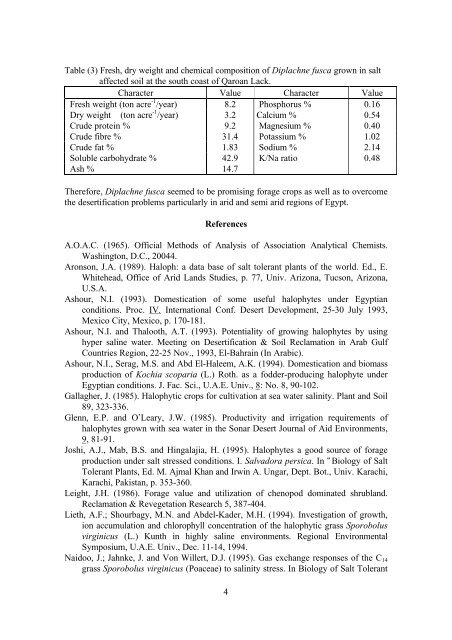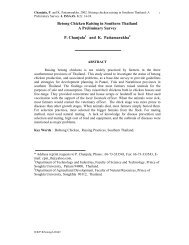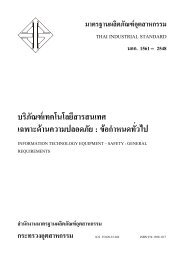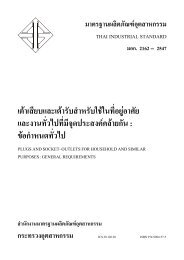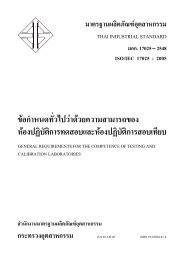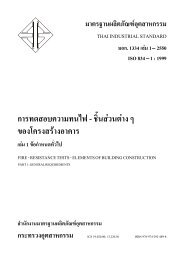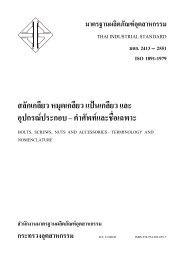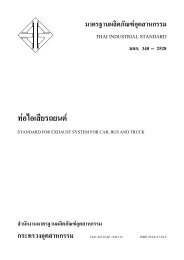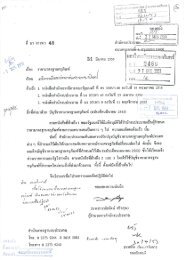Full text
Full text
Full text
You also want an ePaper? Increase the reach of your titles
YUMPU automatically turns print PDFs into web optimized ePapers that Google loves.
Table (3) Fresh, dry weight and chemical composition of Diplachne fusca grown in salt<br />
affected soil at the south coast of Qaroan Lack.<br />
Character Value Character Value<br />
Fresh weight (ton acre -1 /year) 8.2 Phosphorus % 0.16<br />
Dry weight (ton acre -1 /year) 3.2 Calcium % 0.54<br />
Crude protein % 9.2 Magnesium % 0.40<br />
Crude fibre % 31.4 Potassium % 1.02<br />
Crude fat % 1.83 Sodium % 2.14<br />
Soluble carbohydrate % 42.9 K/Na ratio 0.48<br />
Ash % 14.7<br />
Therefore, Diplachne fusca seemed to be promising forage crops as well as to overcome<br />
the desertification problems particularly in arid and semi arid regions of Egypt.<br />
References<br />
A.O.A.C. (1965). Official Methods of Analysis of Association Analytical Chemists.<br />
Washington, D.C., 20044.<br />
Aronson, J.A. (1989). Haloph: a data base of salt tolerant plants of the world. Ed., E.<br />
Whitehead, Office of Arid Lands Studies, p. 77, Univ. Arizona, Tucson, Arizona,<br />
U.S.A.<br />
Ashour, N.I. (1993). Domestication of some useful halophytes under Egyptian<br />
conditions. Proc. IV. International Conf. Desert Development, 25-30 July 1993,<br />
Mexico City, Mexico, p. 170-181.<br />
Ashour, N.I. and Thalooth, A.T. (1993). Potentiality of growing halophytes by using<br />
hyper saline water. Meeting on Desertification & Soil Reclamation in Arab Gulf<br />
Countries Region, 22-25 Nov., 1993, El-Bahrain (In Arabic).<br />
Ashour, N.I., Serag, M.S. and Abd El-Haleem, A.K. (1994). Domestication and biomass<br />
production of Kochia scoparia (L.) Roth. as a fodder-producing halophyte under<br />
Egyptian conditions. J. Fac. Sci., U.A.E. Univ., 8: No. 8, 90-102.<br />
Gallagher, J. (1985). Halophytic crops for cultivation at sea water salinity. Plant and Soil<br />
89, 323-336.<br />
Glenn, E.P. and O’Leary, J.W. (1985). Productivity and irrigation requirements of<br />
halophytes grown with sea water in the Sonar Desert Journal of Aid Environments,<br />
9, 81-91.<br />
Joshi, A.J., Mab, B.S. and Hingalajia, H. (1995). Halophytes a good source of forage<br />
production under salt stressed conditions. I. Salvadora persica. In “Biology of Salt<br />
Tolerant Plants, Ed. M. Ajmal Khan and Irwin A. Ungar, Dept. Bot., Univ. Karachi,<br />
Karachi, Pakistan, p. 353-360.<br />
Leight, J.H. (1986). Forage value and utilization of chenopod dominated shrubland.<br />
Reclamation & Revegetation Research 5, 387-404.<br />
Lieth, A.F.; Shourbagy, M.N. and Abdel-Kader, M.H. (1994). Investigation of growth,<br />
ion accumulation and chlorophyll concentration of the halophytic grass Sporobolus<br />
virginicus (L.) Kunth in highly saline environments. Regional Environmental<br />
Symposium, U.A.E. Univ., Dec. 11-14, 1994.<br />
Naidoo, J.; Jahnke, J. and Von Willert, D.J. (1995). Gas exchange responses of the C14<br />
grass Sporobolus virginicus (Poaceae) to salinity stress. In Biology of Salt Tolerant<br />
4


